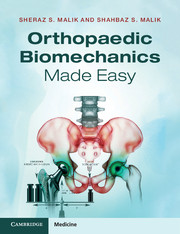Book contents
- Frontmatter
- Dedication
- Contents
- Contributors
- Epigraph
- Preface
- Acknowledgements
- Part I Orthopaedic biomaterials and their properties
- 1 Introduction to orthopaedic biomechanics
- 2 Orthopaedic biomaterials and their properties
- Part II Engineering theory applied to orthopaedics
- Part III Clinical biomechanics
- Index
1 - Introduction to orthopaedic biomechanics
from Part I - Orthopaedic biomaterials and their properties
Published online by Cambridge University Press: 05 June 2015
- Frontmatter
- Dedication
- Contents
- Contributors
- Epigraph
- Preface
- Acknowledgements
- Part I Orthopaedic biomaterials and their properties
- 1 Introduction to orthopaedic biomechanics
- 2 Orthopaedic biomaterials and their properties
- Part II Engineering theory applied to orthopaedics
- Part III Clinical biomechanics
- Index
Summary
Introduction to orthopaedic biomechanics
Orthopaedic surgery is the branch of medicine that deals with congenital and developmental, degenerative and traumatic conditions of the musculoskeletal system. Mechanics is the science concerned with loads acting on physical bodies and the effects produced by these loads. Biomechanics is the application of mechanics to biological systems. Therefore, orthopaedic biomechanics is about the effects of loads acting on the musculoskeletal system only or with the associated orthopaedic interventions.
Mechanics, and therefore biomechanics, is divided into two main domains:
Statics is concerned with the effects of loads without reference to time. Static analysis is applied when the body is stationary or at one instant in time during dynamic activity.
Dynamics addresses the effects of loads over time. It is further divided into two main subjects:
The main functions of the musculoskeletal system are to support loads and to provide motion of body segments. These two functions come together to achieve the musculoskeletal system's third main purpose: to provide locomotion, i.e. movement from one place to another. These are all mechanical tasks and therefore mechanics can be applied to the musculoskeletal system in the same way as to ordinary mechanical systems. Biomechanics is, in fact, a fundamental basis of orthopaedic practice: the mechanics of the body guide the principles of orthopaedic interventions. Biomechanics is also central to the design and function of modern orthopaedic devices. The orthopaedic surgeon therefore has the responsibility to understand musculoskeletal biomechanics and materials and structural limitations of orthopaedic devices and the principles of their application in order to minimise failure.
- Type
- Chapter
- Information
- Orthopaedic Biomechanics Made Easy , pp. 2 - 23Publisher: Cambridge University PressPrint publication year: 2015
- 2
- Cited by



